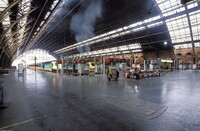| dc.coverage.spatial | Site: London, England, United Kingdom | en_US |
| dc.coverage.temporal | 1863-1876 (creation); ca. 2000-2005 (restoration) | en_US |
| dc.creator | Barlow, William Henry | en_US |
| dc.creator | Scott, George Gilbert, I | en_US |
| dc.date | 1863-1876 | en_US |
| dc.date.accessioned | 2013-03-18T17:20:17Z | |
| dc.date.available | 2013-03-18T17:20:17Z | |
| dc.date.issued | 1863-1876 | en_US |
| dc.identifier | 200428 | en_US |
| dc.identifier.other | archrefid: 1221 | en_US |
| dc.identifier.uri | http://hdl.handle.net/1721.3/108190 | |
| dc.description | General view of the massive shed, from the southwest corner; At the London end of the route Barlow designed the overall layout and the train-shed of the Midland terminus at St Pancras (1863-1868), one of the most important stations of its kind in the world. From an engineering aspect the most spectacular feature of St Pancras Station is the 75 m wide train-shed roof, consisting of 24 principal wrought-iron ribs, which span the station with no ties above platform level. As an arched roof this was not surpassed in size until the 1890s. Barlow described the necessity for a single arch as the natural outcome of the peculiarities of the site, but his design was probably just as much the result of a quest for structural innovation for its own sake. Whereas other arched roofs generally had a high-level tie or a crescent truss, Barlow devised the ingenious solution of tying the St Pancras ribs with girders that run beneath the platforms forming the roof structure of the basement. Because the ribs are secured at low level the side walls of the station have only a secondary function of supporting the intermediate ribs and the wind ties. As Barlow's roof neared completion work started on the hotel that fronts the station (1866-1876), designed by George Gilbert Scott I. Many critics have referred to the contrast between the forthright functionalism of the train-shed and the secular Gothic fantasy of the hotel as a clear illustration of the indecisiveness of Victorian architecture; however, in the late 20th century the view of Barlow's contemporaries that the different parts combine well together was again emphasized. Source: Grove Art Online; http://www.groveart.com/ (accessed 1/25/2008) | en_US |
| dc.format.medium | brick; iron; glass | en_US |
| dc.rights | © Scott Gilchrist, Archivision, Inc. | en_US |
| dc.subject | architectural exteriors | en_US |
| dc.subject | Transportation | en_US |
| dc.subject | Victorian | en_US |
| dc.subject | Gothic Revival | en_US |
| dc.title | Saint Pancras Station | en_US |
| dc.title.alternative | St. Pancras Station | en_US |
| dc.type | image | en_US |
| dc.rights.access | Licensed for educational and research use by the MIT community only | en_US |
| dc.identifier.vendorcode | 1A2-E-L-SP-D6 | en_US |
| vra.culturalContext | British | en_US |
| vra.technique | construction (assembling) | en_US |
| vra.worktype | railroad station | en_US |
| vra.worktype | hotel (public accommodation) | en_US |
| dc.contributor.display | George Gilbert Scott I (British architect, 1811-1878); William Henry Barlow (British structural engineer, 1812-1902) | en_US |


